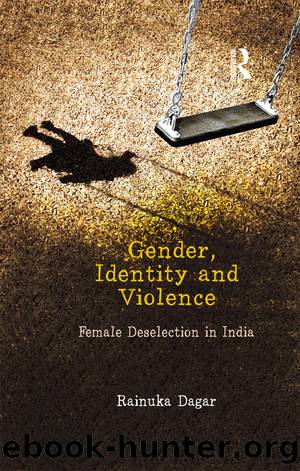Gender, Identity and Violence by Rainuka Dagar

Author:Rainuka Dagar [Dagar, Rainuka]
Language: eng
Format: epub
Tags: Social Science, Gender Studies, Women's Studies, Sociology, General
ISBN: 9781317341598
Google: gW0wCgAAQBAJ
Publisher: Routledge
Published: 2015-07-17T02:47:58+00:00
V
Gender Positioning within the Cultural
Support Structures
Community support mechanisms are crucial survival strategies for populations in South Asia. Social networks and connectivity based in cultural identity, organised around customs and social order are part of a life cycle of material exchange. In recent literature, social networks â as institutionalised group relations termed âsocial capitalâ â have been studied as investment strategies for use of individual benefits by enabling collective actions critical for growth, power, equity, and poverty reduction. Bourdieu, credited with the contemporary conceptualisation of social capital, focuses on individual opportunities through social connections. He defines social capital as, âThe aggregate of the actual or potential resources which are linked to possession of a durable network of more or less institutionalised relationships of mutual acquaintance or recognitionâ (Bourdieu 1985: 51). The World Bank has drawn on the concept for promoting development, including poverty alleviation, and extending the scope to a collective resource (Grootaert 1998). It understands social capital as âthe rules, norms, obligations, reciprocity, and trust embedded in social relations, social structures and societiesâ institutional arrangements which enable members to achieve their individual and community objectivesâ (Narayan 1997: 50). Coleman (1990) draws attention to the family-evoked obligations and expectations that generate social capital and accompanying norms of conduct and regulating sanctions. In India, societies have historically been organised on the principle of mutual exchange and cooperation, based on a relational hierarchy. The present analysis studies if these arrangements are socially structured on patriliny networks, building cohesion and solidarity through customs, rules and practices exclusively related to the lineage, what are the implications for gender equality and womenâs positioning? Is social capital availed by the collectivity for socio-economic well-being imbued with gender norms? Then to what extent is male child preference institutionalised in the existing socio-cultural reservoir, codified in kinship exchange and norms of social conduct. If this social capital regenerates in times of economic struggle and political polarisation and becomes the basis for identity formation, does the male child become critical to the identity?
A comparison has been made between the nature and pattern of support exchanged among the Jats in Haryana and Jat Sikh Punjabi diaspora. in both haryana and Punjab, womenâs life chances have historically remained poor and the states have the worst child sex ratios in the country. in relation to the diaspora, the role of social capital in providing risk protection and decreasing livelihood vulnerability is well-documented in migration research (Gross and Lindquist 1995). But do kinship or religio-caste ties of the Punjabi Sikh transcend country barriers to draw cooperation, security and trust from its members maintaining group solidarity? is there a pattern of support, shared values and norms that regenerate a collective identity throughout the life cycle? it is this cultural identity in which gender asymmetries are placed to explore the male lineage as a source of social authority and a reservoir across boundaries of nations, development and social formations. The social capital of the Jat brotherhood or bhaichara of haryana is uncovered in detail through the institutional structure, normative order, customs, and the terms of material exchange.
Download
This site does not store any files on its server. We only index and link to content provided by other sites. Please contact the content providers to delete copyright contents if any and email us, we'll remove relevant links or contents immediately.
Cecilia; Or, Memoirs of an Heiress — Volume 1 by Fanny Burney(32080)
Cecilia; Or, Memoirs of an Heiress — Volume 3 by Fanny Burney(31471)
Cecilia; Or, Memoirs of an Heiress — Volume 2 by Fanny Burney(31420)
The Great Music City by Andrea Baker(30801)
We're Going to Need More Wine by Gabrielle Union(18647)
All the Missing Girls by Megan Miranda(14802)
Pimp by Iceberg Slim(13807)
Bombshells: Glamour Girls of a Lifetime by Sullivan Steve(13703)
Fifty Shades Freed by E L James(12928)
Talking to Strangers by Malcolm Gladwell(12892)
Norse Mythology by Gaiman Neil(12864)
For the Love of Europe by Rick Steves(11575)
Crazy Rich Asians by Kevin Kwan(8902)
Mindhunter: Inside the FBI's Elite Serial Crime Unit by John E. Douglas & Mark Olshaker(8727)
The Lost Art of Listening by Michael P. Nichols(7171)
Enlightenment Now: The Case for Reason, Science, Humanism, and Progress by Steven Pinker(6884)
The Four Agreements by Don Miguel Ruiz(6330)
Bad Blood by John Carreyrou(6286)
Weapons of Math Destruction by Cathy O'Neil(5854)
